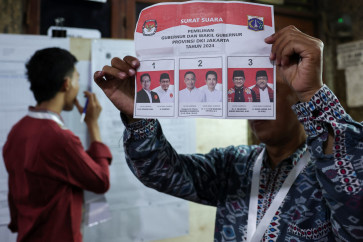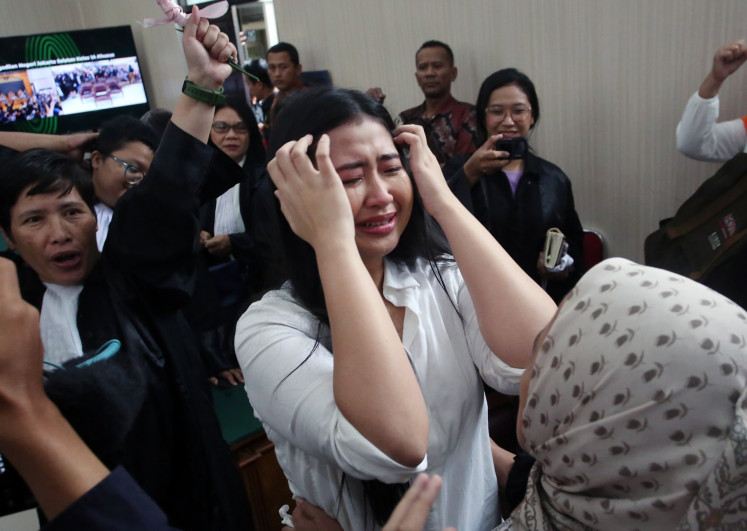Popular Reads
Top Results
Can't find what you're looking for?
View all search resultsPopular Reads
Top Results
Can't find what you're looking for?
View all search resultsIndonesia’s Submarine Corps history and map of Asian conflict
Line of defense: The KRI Ardadedali-404 arrives at the Indonesian Navy’s base in Surabaya, East Java, from South Korea in May 2018
Change text size
Gift Premium Articles
to Anyone
L
ine of defense: The KRI Ardadedali-404 arrives at the Indonesian Navy’s base in Surabaya, East Java, from South Korea in May 2018. The KRI Ardadedali-404 is the second submarine jointly produced by South Korea’s Daewoo Shipbuilding and Marine Engineering and Indonesia’s PT PAL Indonesia. (JP/Wahyoe Boediwardhana)
The Navy’s Hiu Kencana Submarine Corps was officially established on Sept. 12, 1959, following the arrival of two Whiskey class submarines built in the Soviet Union. The two submarines, measuring 76 meters long and having 12 torpedo tubes each, berthed at the Surabaya port on Sept. 7, 1959.
The submarines were sailed from Vladivostok by Indonesian Navy submarine crews, who had been on a study assignment in Poland for several months from August 1958 and had obtained submarine navigation certificates.
After being used during a week of training by Russian instructors in Surabaya, the two subs were officially incorporated into the Indonesian naval force on Sept. 12, 1959, respectively christened RI Tjakra/S-01 and RI Nanggala/S-02. September 12 was later declared the birth date of the Indonesian Navy’s Submarine Corps.
Indonesia sent 110 submarine crew trainees to then-Eastern Europe as an embryo of the country’s undersea combat force. For nine months they were trained by Russian personnel in Gdanks, Poland, with navigating practice in the Baltic Sea, before proceeding to Vladivostok to sail the two subs home.
Since then, Indonesia has possessed a complete naval force capacity of operating on the water surface, undersea, on land and in the air, conforming to the naval concept of the future. Indonesia later ordered 10 new subs of the same class from Russia. The second batch of four subs arrived in December 1961, respectively named RI Nagabanda, RI Trisula, RI Nagarangsang and RI Tjandrasa.
In line with the Trikora campaign to regain Dutch colonized West Irian in December 1962, six other subs armed with SEAT-50 torpedoes arrived. The fire-and-forget torpedo type was the best of that time and besides Russia, only Indonesia was allowed to own this type. The six were named RI Widjajadanu, RI Hendradjala, RI Bramasta, RI Pasopati, RI Tjundamani and RI Alugoro, all derived from the lethal weapons in wayang (shadow puppet play) stories.
Of the 12 subs once owned by the Indonesian Navy, the names and numbers were in the following order: RI Tjakra (401), RI Nanggala (402), RI Nagabanda (403), RI Trisula (404), RI Nagarangsang (405), RI Tjandrasa (406), RI Alugoro (407), RI Tjumandani (408), RI Widjajadanu (409), RI Pasopati (410), RI Hendradjala (411) and RI Bramastra (412).
The 12 subs were promptly deployed in the Jayawijaya operation as part of the Trikora drive. In the dramatic operation, three subs managed to infiltrate the northern coast of West Irian. Two of the three were intercepted by Dutch sea patrols. Only RI Tjandrasa succeeded in landing 15 Special Forces members in Tanah Merah, some 30 kilometers north of Sentani Airport, on Aug. 21, 1962, for which its crew members were awarded Bintang Sakti medals in 1963.
With diplomatic ties between Indonesia and Russia deteriorating, the Whiskey subs’ contribution declined after Russia imposed a spare part boycott that resulted in vessel cannibalization and their gradual inactivation. The last Whiskey sub retired from the Indonesian Navy’s warship armada was RI Pasopati, which is currently displayed as a submarine monument in Surabaya.
The Indonesian Navy later ordered SS 209/1300-type subs in 1977 from Germany. The two were built by the Howaldtswerke shipyard in Kiel, West Germany. In June 1981, KRI Cakra-401 and KRI Nangggala-402 strengthened the naval armada. With only two subs, the Navy certainty felt a big shortage in the means to safeguard national waters, which cover two-thirds of the archipelagic state.
Nonetheless, up until the early 1990s, Indonesia remained highly respected for being the only country in Southeast Asia with a submarine fleet. However, Singapore and Malaysia went on to reinforce their armadas with the same vessels.
Submarines and conflict in Asia
As witnessed by observers, Asia is expected to retain several conflict areas in 2019 until sometime in the future. This includes the conflict on the Korean Peninsula and in the South China Sea as far as the Taiwan Strait, with the potential for military confrontation. This means the countries involved are likely to undertake large-scale military modernization, including of their naval forces.
Especially in naval force rivalry, the last few years have seen Asia and Southeast Asia as the zones with the fastest growing submarine numbers in the world. Over the next several years, the number of subs in these regions will increase from 200 to 250.
Singapore, previously owning just four subs from former Swedish Navy’s Challenger class of the 1960s and Archer class of 1995, has decided to buy four of the newest Invincible-class 218SG-type subs from Thyssenkrupp Marine Systems (TKSM) in Germany. The first subs ordered by Singapore are expected to be officially be put in service in 2021.
Thailand, practically having no subs since 1951, has also decided to purchase three S26-T subs developed on the basis of Yuan-class 039 A-type owned by the Chinese navy, with a total contract value of US$104.2 million.
In 2009, Vietnam signed a purchase agreement for six modern electric diesel subs under project 636 of the Varshavyanka class, better known by the NATO reporting name as the Russian made Kilo class, worth $2 billion. The six almost silent electric diesel subs are a major boost in Vietnam’s undersea power and balances the Chinese navy’s strength in the South China Sea conflict.
The Malaysian navy is being reinforced with two Scorpene-class subs produced under cooperation between French DCNS and Spanish Navantia.
In the south, Australia in February signed a submarine building contract worth A$50 billion ($35 billion) with a French company for 12 Shortfin Barracuda Block 1A electric diesel assault subs in its modernization efforts. The first sub is expected to come into operation in 2030 and the last one in 2040.
The Royal Australian Navy currently has six Collins-class subs, which were designed in Sweden but built by an Australian shipyard. The latest of this class was produced in 2003.
Indonesia, which has the vastest sea territory in Southeast Asia, aims to eventually own 12 new subs. In early 2019, the Indonesian Navy secured three new 209/1400-type Chang Bogo-class electric diesel subs built by South Korean DSME. The government has also signed for three more subs of the same type with a contract value of $1.2 billion. The three medium-sized subs with sophisticated technology will enter Indonesian naval service within six and a half years.
What makes Indonesia different from the other countries in Southeast Asia is that it has the facilities and capability to produce submarines.
“Of the 12 subs required, nine will be domestically built. If 12 subs were made and maintained at home, the state would save considerable foreign exchange. This makes Indonesia different,” Turitan Indaryo, shipbuilding director of PT PAL Indonesia, told The Jakarta Post.
Submarines constitute a weapon of high resistance because they are hard to detect and can carry various armaments like torpedoes, mines and guided missiles. Possessing reliable subs in a sufficient number with a high combat capacity is inevitable in the effort to create a strong Indonesian Navy in which the public can take pride.
As president Sukarno pointed out to the Indonesian Navy’s submarine corps when speaking aboard RI Tjandrasa on Oct., 1966 at Tanjung Priok Port, Jakarta, once they are sailed, they must move forward and never rise to the surface before winning, wira ananta rudhiro (be tough through to the end, in Javanese).
Wira ananta rudhiro has since been the motto of the Submarine Corps.










